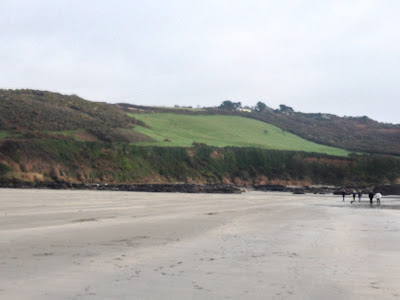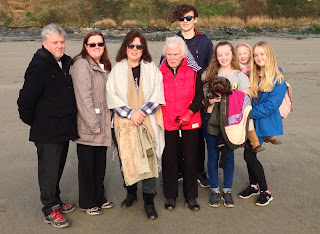This day had been planned as one of the Major reasons for coming to England.
John Sayce had Died 9 Year early and had requested to be buried at St-Just-In-Roseland.
We were finally here, and it was a beautiful day. Jennifer was on the phone early in the morning to her sisters and Gwen had planned the day around the internment as well. so After A Great cooked Breakfast from Gwen.
An early morning walk down on the foreshore of St Mawes, as the Day Rose. past the House of John Parents.
Back to the Church for Johns Interment. we picked up Gwen and some of the Family to Join us.
The church was shrouded in mist but it was bright. The service was conducted by the Church of England Vicar, and was short. She knew we were members of the LDS church so shortened the service to make it appropriate. we Said a few words and laid John's ashes to rest. He is finally at peace in a beautiful place. Surprising for Jenny was the relief that he was now at rest in the beautiful gardens of the church of St-Just-In-Roselands.
John Sayce, 1927-2007, May He Rest In Peace.
After the Interment, we went to visit Jennifer's Cousin "Rickard" the last one to meet on this trip.
We then headed to Pendowner Beach, part of the National Trust of Roseland.
A chance to take Family Photo's and relax.
Oh and to Play with the dogs
By the time we finished the walk, the mode was a Good, Time for Lunch
So off we went to the Philleigh Pub, known as the Roseland Inn for Lunch.
The family and atmosphere were great, so were the Scallops in crisp Seaweed Salad
and Pheasant Breast with roast Beetroot and Forest Mushrooms.
after this, we went back to St Mawes for Cornish Icecreams.
Finished the Day at the St Mawes Castle. This is where we have Photo's of John just before he went to Australia in 1950.
We finished with Scones and Cornish clotted cream as an evening snack talking to family.
By the time we finished the walk, the mode was a Good, Time for Lunch
So off we went to the Philleigh Pub, known as the Roseland Inn for Lunch.
The family and atmosphere were great, so were the Scallops in crisp Seaweed Salad
and Pheasant Breast with roast Beetroot and Forest Mushrooms.
after this, we went back to St Mawes for Cornish Icecreams.
Finished the Day at the St Mawes Castle. This is where we have Photo's of John just before he went to Australia in 1950.
We finished with Scones and Cornish clotted cream as an evening snack talking to family.
















